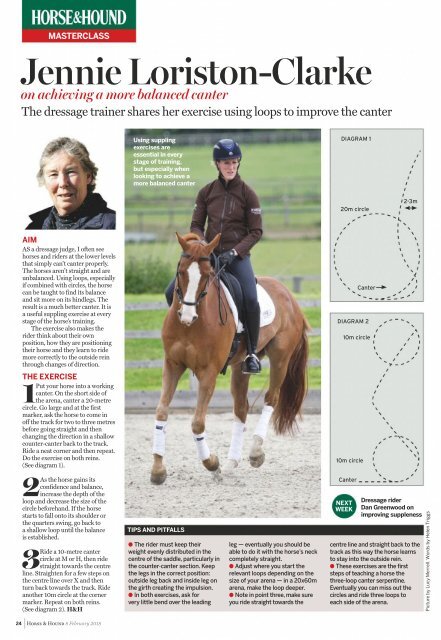Horse_amp_amp_Hound__06_February_2018
You also want an ePaper? Increase the reach of your titles
YUMPU automatically turns print PDFs into web optimized ePapers that Google loves.
MASTERCLASS<br />
Jennie Loriston-Clarke<br />
on achieving a more balanced canter<br />
The dressage trainer shares her exercise using loops to improve the canter<br />
Using suppling<br />
exercises are<br />
essential in every<br />
stage of training,<br />
but especially when<br />
looking to achieve a<br />
more balanced canter<br />
DIAGRAM 1<br />
20m circle<br />
2-3m<br />
AIM<br />
AS a dressage judge, I often see<br />
horses and riders at the lower levels<br />
that simply can’t canter properly.<br />
The horses aren’t straight and are<br />
unbalanced. Using loops, especially<br />
if combined with circles, the horse<br />
can be taught to find its balance<br />
and sit more on its hindlegs. The<br />
result is a much better canter. It is<br />
a useful suppling exercise at every<br />
stage of the horse’s training.<br />
The exercise also makes the<br />
rider think about their own<br />
position, how they are positioning<br />
their horse and they learn to ride<br />
more correctly to the outside rein<br />
through changes of direction.<br />
Canter<br />
DIAGRAM 2<br />
10m circle<br />
THE EXERCISE<br />
1Put your horse into a working<br />
canter. On the short side of<br />
the arena, canter a 20-metre<br />
circle. Go large and at the first<br />
marker, ask the horse to come in<br />
off the track for two to three metres<br />
before going straight and then<br />
changing the direction in a shallow<br />
counter-canter back to the track.<br />
Ride a neat corner and then repeat.<br />
Do the exercise on both reins.<br />
(See diagram 1).<br />
10m circle<br />
2As the horse gains its<br />
confidence and balance,<br />
increase the depth of the<br />
loop and decrease the size of the<br />
circle beforehand. If the horse<br />
starts to fall onto its shoulder or<br />
the quarters swing, go back to<br />
a shallow loop until the balance<br />
is established.<br />
3Ride a 10-metre canter<br />
circle at M or H, then ride<br />
straight towards the centre<br />
line. Straighten for a few steps on<br />
the centre line over X and then<br />
turn back towards the track. Ride<br />
another 10m circle at the corner<br />
marker. Repeat on both reins.<br />
(See diagram 2). H&H<br />
TIPS AND PITFALLS<br />
O The rider must keep their<br />
weight evenly distributed in the<br />
centre of the saddle, particularly in<br />
the counter-canter section. Keep<br />
the legs in the correct position:<br />
outside leg back and inside leg on<br />
the girth creating the impulsion.<br />
O In both exercises, ask for<br />
very little bend over the leading<br />
leg — eventually you should be<br />
able to do it with the horse’s neck<br />
completely straight.<br />
O Adjust where you start the<br />
relevant loops depending on the<br />
size of your arena — in a 20x60m<br />
arena, make the loop deeper.<br />
O Note in point three, make sure<br />
you ride straight towards the<br />
Canter<br />
NEXT<br />
WEEK<br />
Dressage rider<br />
Dan Greenwood on<br />
improving suppleness<br />
centre line and straight back to the<br />
track as this way the horse learns<br />
to stay into the outside rein.<br />
O These exercises are the first<br />
steps of teaching a horse the<br />
three-loop canter serpentine.<br />
Eventually you can miss out the<br />
circles and ride three loops to<br />
each side of the arena.<br />
Picture by Lucy Merrell. Words by Helen Triggs<br />
24 <strong>Horse</strong> & <strong>Hound</strong> 8 <strong>February</strong> <strong>2018</strong>



